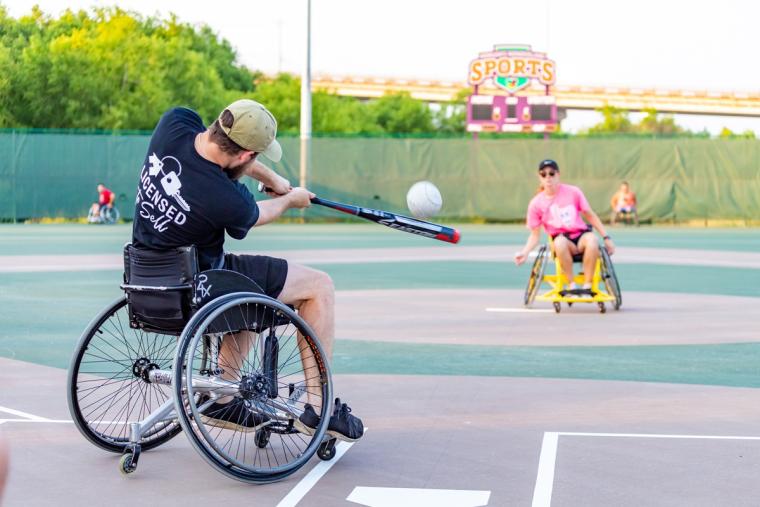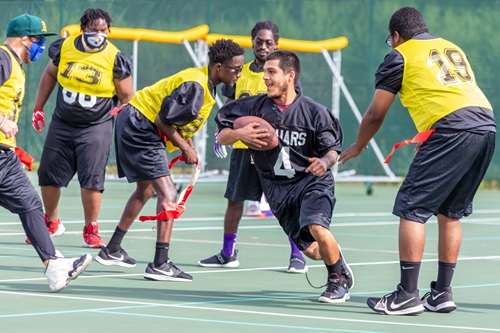
As the number of high school sports participants bounces back toward pre-pandemic levels, adapted and unified sports programs ranging from basketball and softball to track and field, swimming and bocce also are gaining in popularity among high school athletes. Adapted sports allow students with physical disabilities to play in a similar manner to able-bodied participants, while unified sports pair special-needs athletes with athletes without intellectual disabilities.
“Adapted and Unified Sports are the key programs nationally for students with disabilities, with 24 state associations sponsoring championships in some Unified sports and 10 others offering state-culminating events in some Adapted Sports,” notes the National Federation of State High School Associations, which sanctions 16 sports in each of the categories.
“It is great to see a growing interest in several emerging sports, as well as programs like Unified and Adapted programs,” Dr. Karissa Niehoff, CEO of the NFHS, said last spring. “Our goal continues to be to involve as many students as possible in high school sports and other activity programs.”
Those programs no doubt are propelled at the local level by organizations such as the PlayLA Adaptive Youth Sports Program, which recently was awarded the 2023 Marketing & Communications Award of Excellence from the California Park & Recreation Society (CPRS).
Part of the City of Los Angeles Department of Recreation and Park, PlayLA is a city-wide initiative that provides access to inclusive, year-round, quality sports programming for youths of all abilities between the ages of 5 and 17. Made possible by an investment from the LA28 Olympic and Paralympic Games Organizing Committee and the International Olympic Committee, PlayLA is the single largest commitment to youth sports development in California, local officials say, and it is intended to serve as a legacy before, during and after the LA28 Olympic and Paralympic Games.

According to the program’s website:
[O]ver the next six years, the PlayLA Adaptive Youth Sports Program will offer young people with disabilities access to a variety of adaptive sports programming at no cost in a safe and fun environment at their local recreation centers and neighborhood facilities. The first- of-its-kind program in the City of LA aims to remove barriers to participation by providing an underserved community with the opportunity to discover a sport they are passionate about and can pursue.
The PlayLA Adaptive Youth Sports Program raises awareness of the benefits adaptive sports can offer young people with disabilities, including enhancing lifelong leisure pursuits and helping achieve a more equitable quality of life. LA Parks is committed to creating a lasting positive impact through this initiative and fostering a new generation of para-athletes and fans ahead of the LA28 Games.
CPRS singled PlayLA out for how the program “thoughtfully and strategically used marketing and communications to engage the disability community, primarily youth with disabilities and their parents, through face-to-face outreach, distribution of digital and print marketing materials in English and Spanish, online outreach, targeted social media campaigns and media relations. These efforts helped result in over 1,500 youth participating in PlayLA’s inclusive and accessible adaptive sports programming from November 2022 to October 2023.”
Public and private entities around the country are recognizing the intrinsic value of such programming for both youth and adult athletes. They include Rainer Adaptive Sports which was established in Tacoma, Wash., in 2020 and in November received one of two $5,000 grants from radio broadcasting company Seattle Sports. The organization used the money to upgrade equipment for its junior wheelchair basketball team.
Also late last year, Goalies Charlie Lindgren of the NHL’s Washington Capitals and his wife, Mikkayla, announced Lindy’s Lineup — a player program focused on providing opportunities for kids in adaptive sports and special education classrooms. The couple cited Mikkayla’s background and current career in pediatric occupational therapy as the inspiration for the initiative, according to the Capitals.
Early activities included a joint skate with Dowd’s Crowd (which provides opportunities for children with sensory issues to attend Capitals games) and So Kids Soar (which provides free adaptive athletic, recreational and skill-building activities).
“Children with disabilities are prone to be more socially isolated and less physically active than their peers, regardless of their impairment,” according to a pair of pediatric medicine specialists at Children’s Mercy, a medical center in Kansas City, Mo., who wrote about “the power of adaptive sports” in September. “[Adaptive sports] put athletes on an even playing field and build teamwork, confidence and character. More importantly, they help strengthen the body as well as improve endurance and flexibility, reduce body fat and increase lean mass and bone density. Kids who play adaptive sports are also less likely to be anxious or depressed and are more independent later in life.”
While programs such as The Miracle League® (which offers baseball programs and facilities to those with developmental or physical challenges) have been in existence for a long time, another trend to watch is that of multi-sport facilities for athletes with special needs. Morgan’s Sports in San Antonio, Texas is one of these; the venue has facilities for volleyball, baseball, football, basketball, tennis, pickleball and softball.

